Abstract
Aging and cancer share a number of characteristics. This has led to the hypothesis that species' differences in longevity may be governed in part by the same mechanisms as those processes governing species' differences in their age-dependent probability of developing cancer. Much evidence has indicated that beta-carotene and retinol may be important natural anticarcinogens. Accordingly, they also may be important antiaging agents. This possibility has been tested by determining if a positive correlation exists between the concentration of carotenoids and retinol in serum and brain tissue with the maximal life-span potential of mammalian species. The results show a significant positive correlation for the carotenoids but not for retinol. These results suggest that the carotenoids may be biologically active as protective agents against cancer and as longevity determinants. Retinol appears to be less important in these functions.
Full text
PDF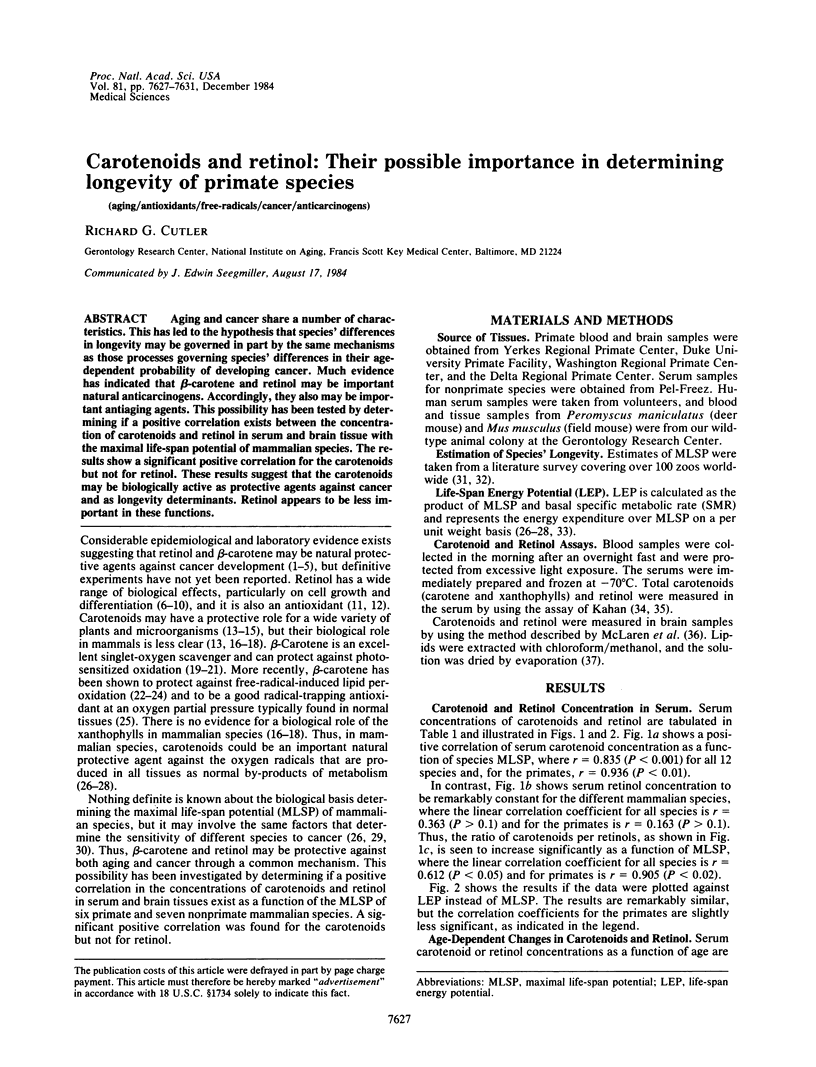
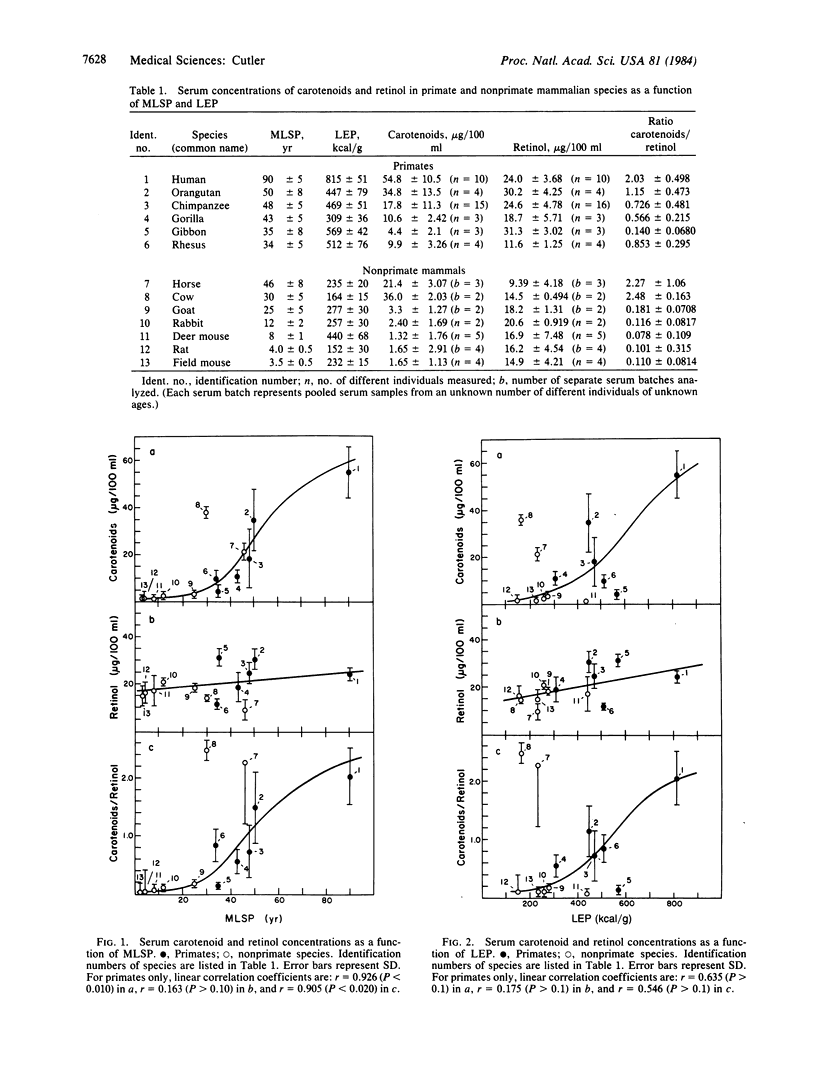
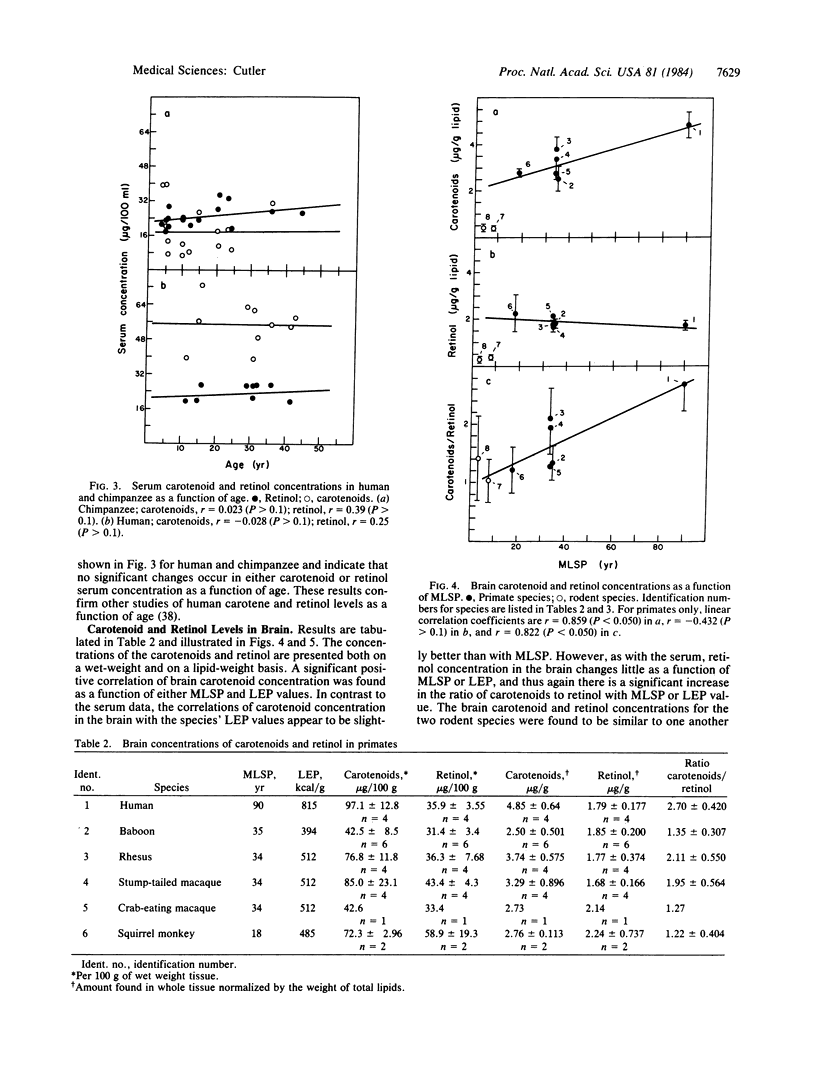
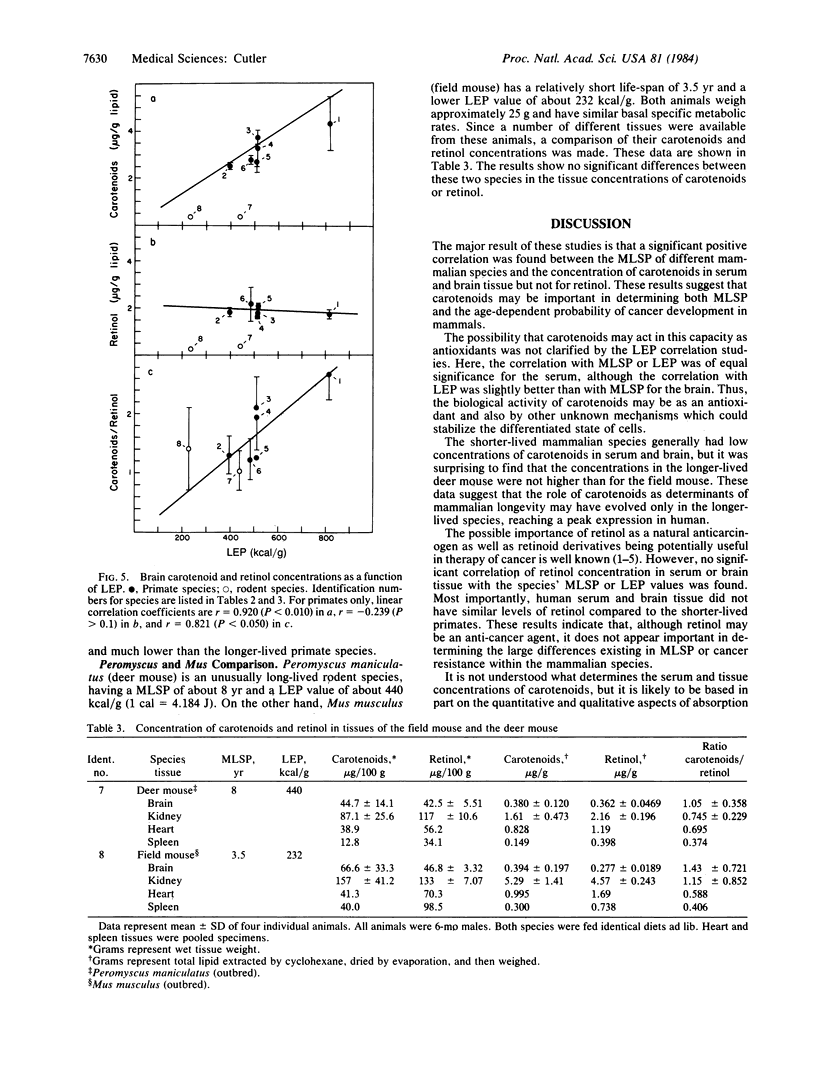
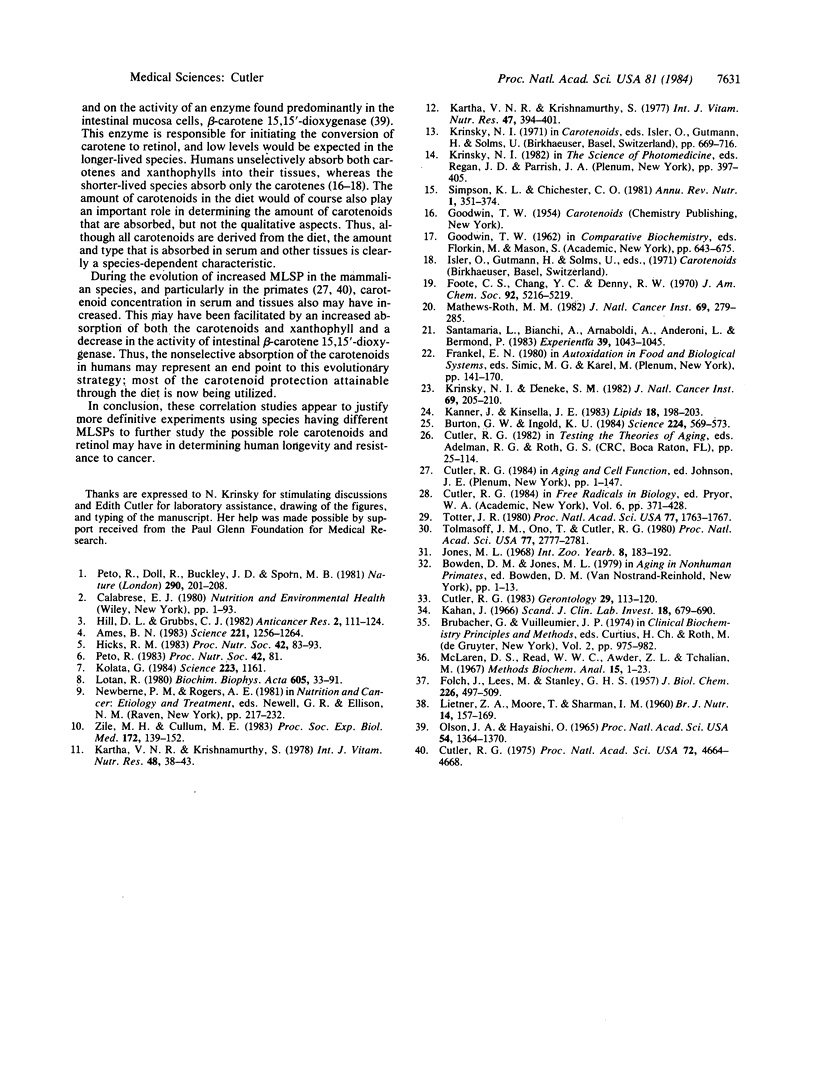
Selected References
These references are in PubMed. This may not be the complete list of references from this article.
- Ames B. N. Dietary carcinogens and anticarcinogens. Oxygen radicals and degenerative diseases. Science. 1983 Sep 23;221(4617):1256–1264. doi: 10.1126/science.6351251. [DOI] [PubMed] [Google Scholar]
- Burton G. W., Ingold K. U. beta-Carotene: an unusual type of lipid antioxidant. Science. 1984 May 11;224(4649):569–573. doi: 10.1126/science.6710156. [DOI] [PubMed] [Google Scholar]
- Cutler R. G. Evolution of human longevity and the genetic complexity governing aging rate. Proc Natl Acad Sci U S A. 1975 Nov;72(11):4664–4668. doi: 10.1073/pnas.72.11.4664. [DOI] [PMC free article] [PubMed] [Google Scholar]
- Cutler R. G. Superoxide dismutase, longevity and specific metabolic rate. A reply. Gerontology. 1983;29(2):113–120. doi: 10.1159/000213102. [DOI] [PubMed] [Google Scholar]
- FOLCH J., LEES M., SLOANE STANLEY G. H. A simple method for the isolation and purification of total lipides from animal tissues. J Biol Chem. 1957 May;226(1):497–509. [PubMed] [Google Scholar]
- Foote C. S., Chang Y. C., Denny R. W. Chemistry of singlet oxygen. X. Carotenoid quenching parallels biological protection. J Am Chem Soc. 1970 Aug 26;92(17):5216–5218. doi: 10.1021/ja00720a036. [DOI] [PubMed] [Google Scholar]
- Hicks R. M. The scientific basis for regarding vitamin A and its analogues as anti-carcinogenic agents. Proc Nutr Soc. 1983 Jan;42(1):83–93. doi: 10.1079/pns19830010. [DOI] [PubMed] [Google Scholar]
- Hill D. L., Grubbs C. J. Retinoids as chemopreventive and anticancer agents intact animals (review). Anticancer Res. 1982 Jan-Apr;2(1-2):111–124. [PubMed] [Google Scholar]
- Kanner J., Kinsella J. E. Lipid deterioration: beta-carotene destruction and oxygen evolution in a system containing lactoperoxidase, hydrogen peroxide and halides. Lipids. 1983 Mar;18(3):198–203. doi: 10.1007/BF02534548. [DOI] [PubMed] [Google Scholar]
- Kartha V. N., Krishnamurthy S. Antioxidant function of vitamin A. Int J Vitam Nutr Res. 1977;47(4):394–401. [PubMed] [Google Scholar]
- Kartha V. N., Krishnamurthy S. Effect of vitamins, antioxidants and sulfhydryl compounds on in vitro rat brain lipid peroxidation. Int J Vitam Nutr Res. 1978;48(1):38–43. [PubMed] [Google Scholar]
- Kolata G. Does vitamin A prevent cancer? Science. 1984 Mar 16;223(4641):1161–1161. doi: 10.1126/science.6701519. [DOI] [PubMed] [Google Scholar]
- Krinsky N. I., Deneke S. M. Interaction of oxygen and oxy-radicals with carotenoids. J Natl Cancer Inst. 1982 Jul;69(1):205–210. [PubMed] [Google Scholar]
- LEITNER Z. A., MOORE T., SHARMAN I. M. Vitamin A and vitamin E in human blood. 1. Levels of vitamin A and carotenoids in British men and women, 1948-57. Br J Nutr. 1960;14:157–170. doi: 10.1079/bjn19600022. [DOI] [PubMed] [Google Scholar]
- Lotan R. Effects of vitamin A and its analogs (retinoids) on normal and neoplastic cells. Biochim Biophys Acta. 1980 Mar 12;605(1):33–91. doi: 10.1016/0304-419x(80)90021-9. [DOI] [PubMed] [Google Scholar]
- Mathews-Roth M. M. Photosensitization by porphyrins and prevention of photosensitization by carotenoids. J Natl Cancer Inst. 1982 Jul;69(1):279–285. [PubMed] [Google Scholar]
- McLaren D. S., Read W. W., Awdeh Z. L., Tchalian M. Microdetermination of vitamin A and carotenoids in blood and tissue. Methods Biochem Anal. 1967;15:1–23. doi: 10.1002/9780470110331.ch1. [DOI] [PubMed] [Google Scholar]
- Olson J. A., Hayaishi O. The enzymatic cleavage of beta-carotene into vitamin A by soluble enzymes of rat liver and intestine. Proc Natl Acad Sci U S A. 1965 Nov;54(5):1364–1370. doi: 10.1073/pnas.54.5.1364. [DOI] [PMC free article] [PubMed] [Google Scholar]
- Peto R., Doll R., Buckley J. D., Sporn M. B. Can dietary beta-carotene materially reduce human cancer rates? Nature. 1981 Mar 19;290(5803):201–208. doi: 10.1038/290201a0. [DOI] [PubMed] [Google Scholar]
- Santamaria L., Bianchi A., Arnaboldi A., Andreoni L., Bermond P. Dietary carotenoids block photocarcinogenic enhancement by benzo (a)pyrene and inhibit its carcinogenesis in the dark. Experientia. 1983 Sep 15;39(9):1043–1045. doi: 10.1007/BF01989795. [DOI] [PubMed] [Google Scholar]
- Simpson K. L., Chichester C. O. Metabolism and nutritional significance of carotenoids. Annu Rev Nutr. 1981;1:351–374. doi: 10.1146/annurev.nu.01.070181.002031. [DOI] [PubMed] [Google Scholar]
- Tolmasoff J. M., Ono T., Cutler R. G. Superoxide dismutase: correlation with life-span and specific metabolic rate in primate species. Proc Natl Acad Sci U S A. 1980 May;77(5):2777–2781. doi: 10.1073/pnas.77.5.2777. [DOI] [PMC free article] [PubMed] [Google Scholar]
- Totter J. R. Spontaneous cancer and its possible relationship to oxygen metabolism. Proc Natl Acad Sci U S A. 1980 Apr;77(4):1763–1767. doi: 10.1073/pnas.77.4.1763. [DOI] [PMC free article] [PubMed] [Google Scholar]
- Zile M. H., Cullum M. E. The function of vitamin A: current concepts. Proc Soc Exp Biol Med. 1983 Feb;172(2):139–152. doi: 10.3181/00379727-172-41537. [DOI] [PubMed] [Google Scholar]


